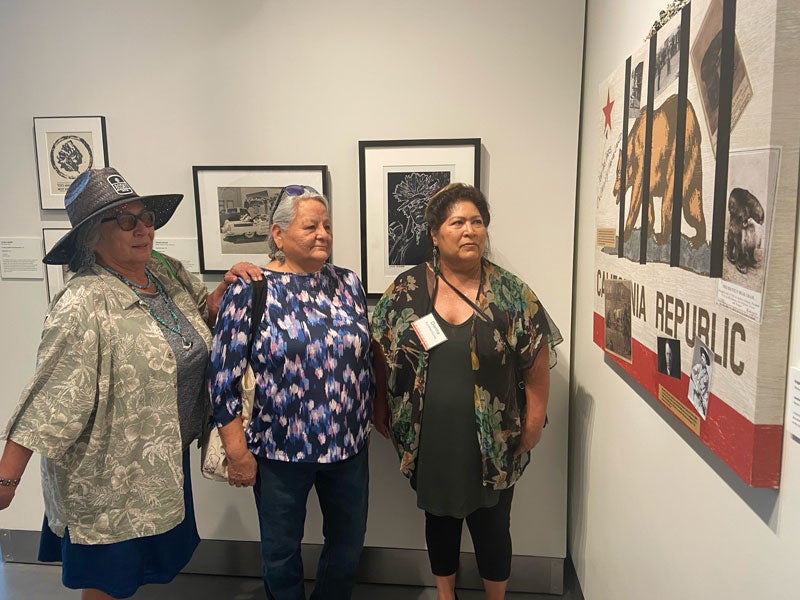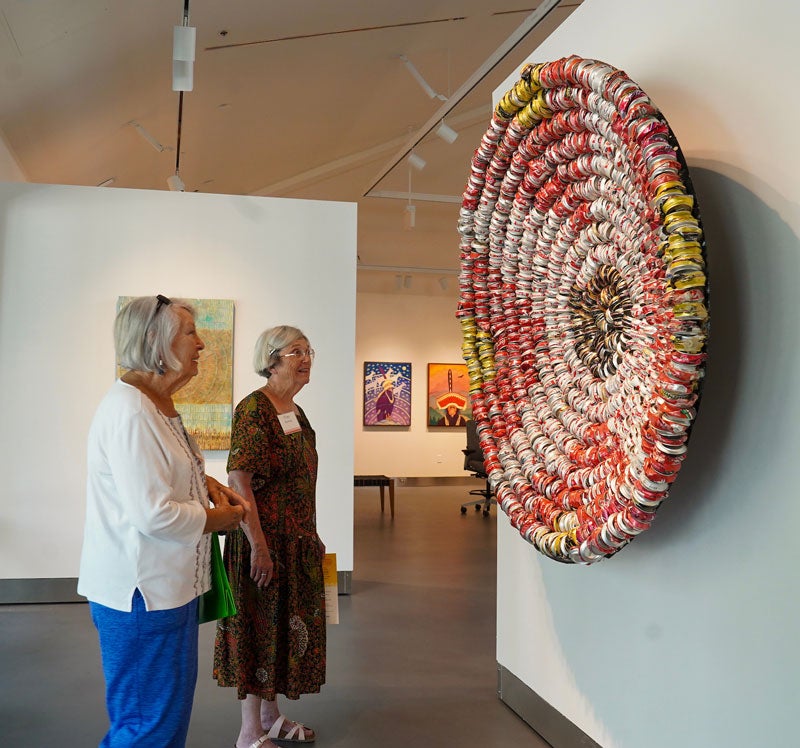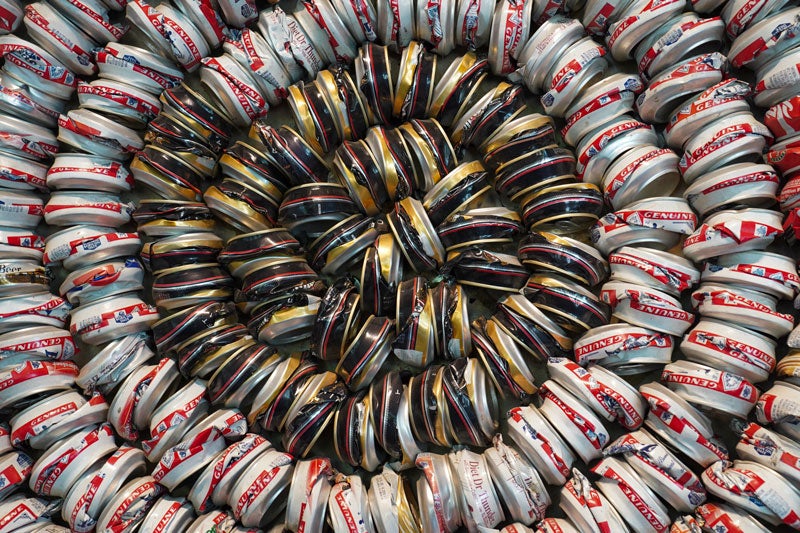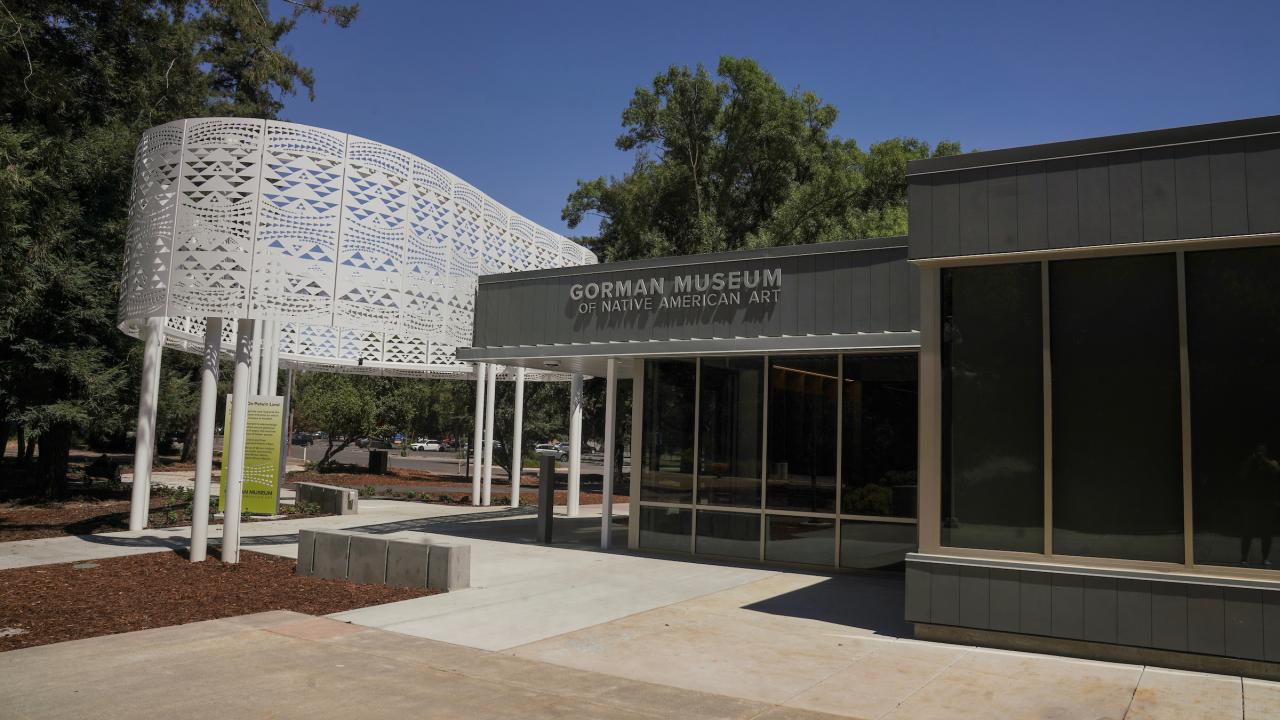Celebrating its 50th anniversary, the Gorman Museum of Native American Art at University of California, Davis, came to life in its new 4,000-square foot space with a ribbon cutting and two days of celebrations Sept. 22 and 23, attracting more than 1,000 people.
Visit the museum
Gorman Museum of Native American Art, 181 Old Davis Road, Davis.
Open noon to 5 p.m. on weekends; 11 a.m. to 5 p.m. Wednesday-Friday
Admission is free.
The museum contains more than 2,000 works — many on display now as it opens to the public. Its outer walls are painted with a design giving homage to Tlaka, the Wintun word for California tule grasses, and a white pavilion of triangles honors Patwin language and cultural keeper Bertha Wright Mitchell (1936-2018). It is at once an extraordinary, beautiful, surprising reconstruction of an old campus space used both as a restaurant and an art gallery in its previous lives.
Hulleah Tsinhnahjinnie is the director of the Gorman Museum as well as professor of Native American studies and a multimedia artist. She guided a new visitor past the entrance she designed — to the art inside.
The grizzly and Native Americans
“Come see this,” she said, tilting her head toward a work located to the left of the first of three galleries.
It’s clear that she wants to illustrate to visitors what the museum represents, proud of the art she and Veronica Passalacqua, the curator and executive director, have acquired for the museum’s opening exhibition, “Contemporary California Native Art.”
A red and white California flag, with the characteristic growling grizzly bear, hangs to the left.
But upon a closer look, the bear depicted above the “California Republic” lettering has bars painted vertically over his body, as if in a cage or prison cell. The red star in the top left corner, normally shown alone in that space on the flag, has scrawled beneath it in handwriting, “You are Here on Grizzly Homeland.” In the mixed-media piece are old photos of a hunter, news items about the legendary bear, and among other things, a picture of a disturbing piece of furniture — a chair made of bear legs, claws and fur.

“The bear — one of the last of the grizzlies, was in captivity,” Tsinhnahjinnie said, pointing at the fine points of the collage. The artist, Pam Pulsifer-Gonzales (Wintun/Huchnom/Concow,) said in conversation with Tsinhnahjinnie, “That’s what they did to us. We are like the bear.”
“Pam has created a piece that requires deep reflection. The symbolism of the California flag should be questioned,” said Tsinhnahjinnie (pronounced Sin-na-jinny).
The description of the art — as with most pieces in the museum — is written by the artist:
I cannot speak for the Grizzly. I am letting the perpetrators’ own documentation tell the story of why and how the Grizzly became extinct in the Golden State.” — Pam Pulsifer-Gonzales, Wintun/Concow/Huchnom
Visual sovereignty
There are many pieces that illustrate the history, culture and politics of being Native Americans throughout the museum.
Near the grizzly piece is a 5-foot-wide, coiled, Cahuilla basket tray, made of crushed aluminum cans once filled with alcoholic beverages and sugary sodas. It is visible through the front window of the museum. This piece, “Continuum Basket, 2022,” was created by Gerald Clark Jr. (Cahuilla), a UC Riverside professor of ethnic studies. It is meant to represent the diabetes and alcoholism that have afflicted Native people.
“When we tell these stories, especially Native histories of colonization, we are constantly opening our chest. It’s painful,” said Tsinhnahjinnie, who is Diné and Seminole/Muscogee.
“Sometimes you need to see a piece that will give you empowerment; sometimes you need a piece that reminds you of beauty,” she said. “The artwork creates a perspective from the shore, the homelands. The artist reclaims a space where visual sovereignty empowers.”


The museum is committed to contemporary Native American art that enacts visual sovereignty — recognizing Natives have their own story to tell — through politically and socially engaging exhibitions. The opening coincided with the annual Native American Day at the state capitol in Sacramento on Sept. 22.
A museum of firsts
Tsinhnahjinnie explained that the museum is a first in many categories. It’s the first museum in the University of California system dedicated solely to Native American art. It’s an unusual commitment to Native American art and culture among research universities. There are only a few such museums on the North American continent.
And it’s important for Native American studies in general. The UC Davis department, founded in 1969, is one of the oldest Native American studies programs. UC Davis is one of three U.S. universities that offer a doctorate in Native American studies.
The Gorman — named for Carl Nelson Gorman, a founding member of the Department of Native American Studies — was conceptualized in the department and grew to become a public venue.
“Native Americans have not vanished or disappeared. We are very present,” Tsinhnahjinnie said. “The UC Davis community, and others who visit the Gorman, will witness a very vibrant, Native American art community who visualize the complexities of being Native through art.”
UC Davis and Patwin land
UC Davis is located on land that has for thousands of years been home to the Patwin people. There are three federally recognized Patwin tribes: Cachil DeHe Band of Wintun Indians of the Colusa Indian Community, Kletsel Dehe Wintun Nation and Yocha Dehe Wintun Nation. View the full land acknowledgment statement.
Media Resources
Related: “Gorman Museum of Native American Art Reopening in New, Expanded Home” (News release, Aug. 22)
Media Contact:
- Karen Nikos-Rose, News and Media Relations, 530-219-5472, kmnikos@ucdavis.edu
